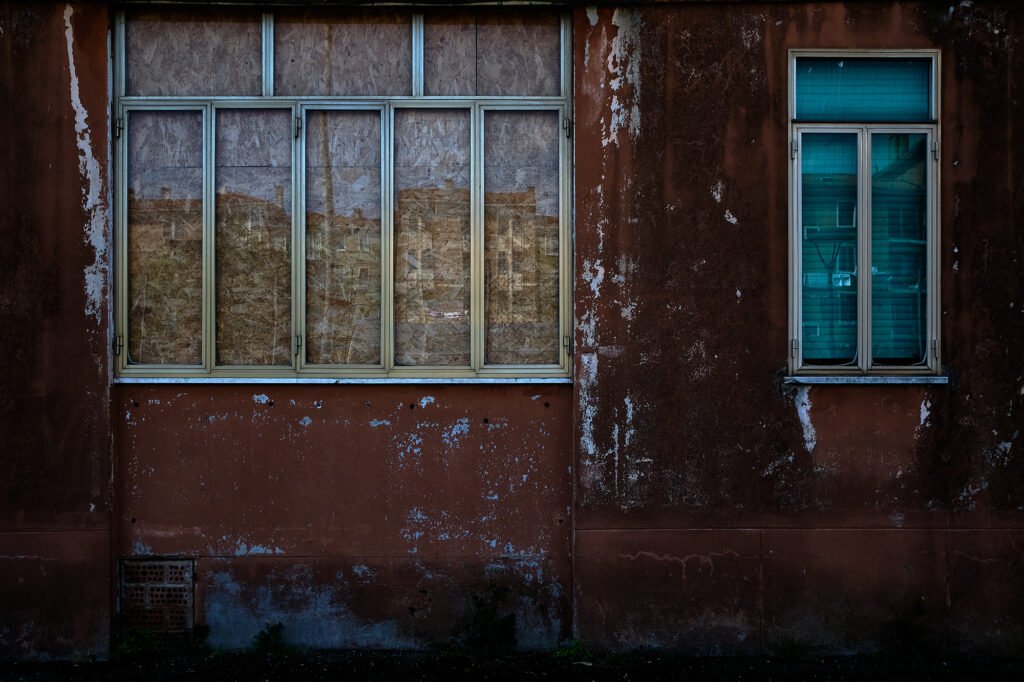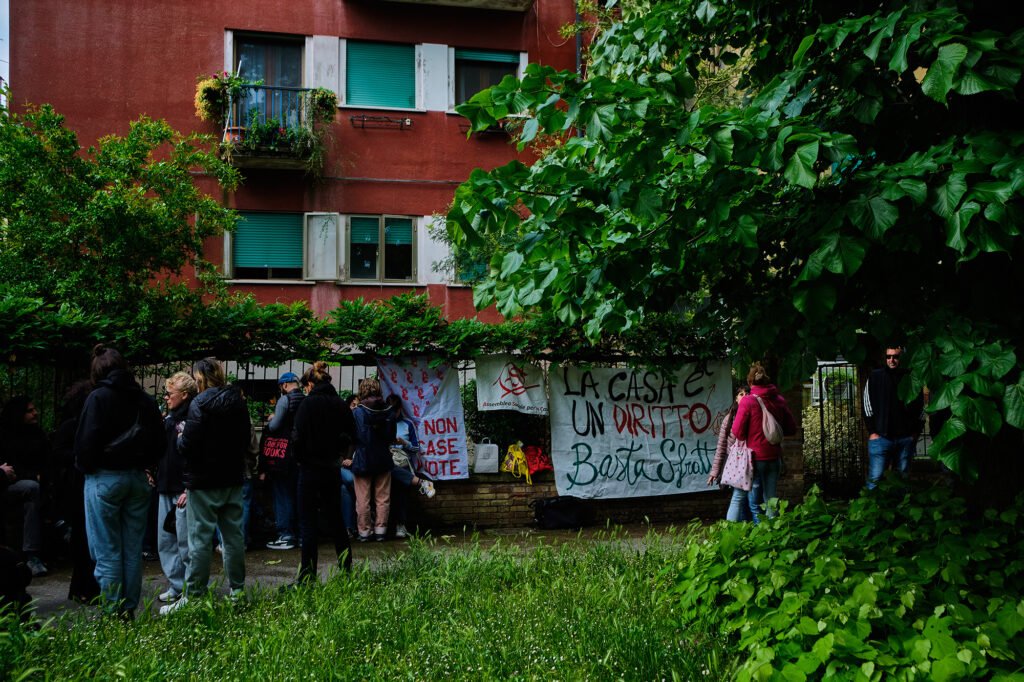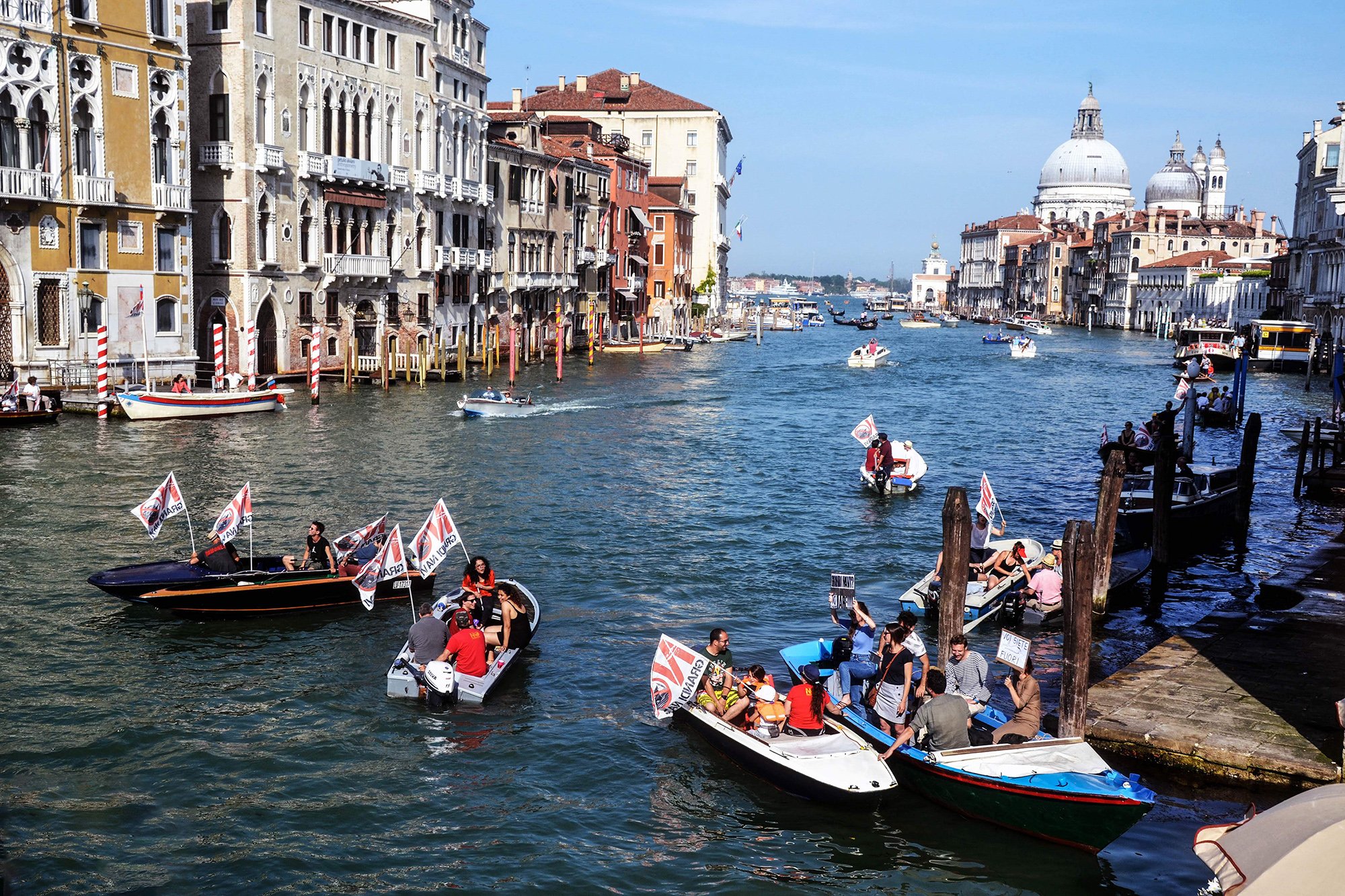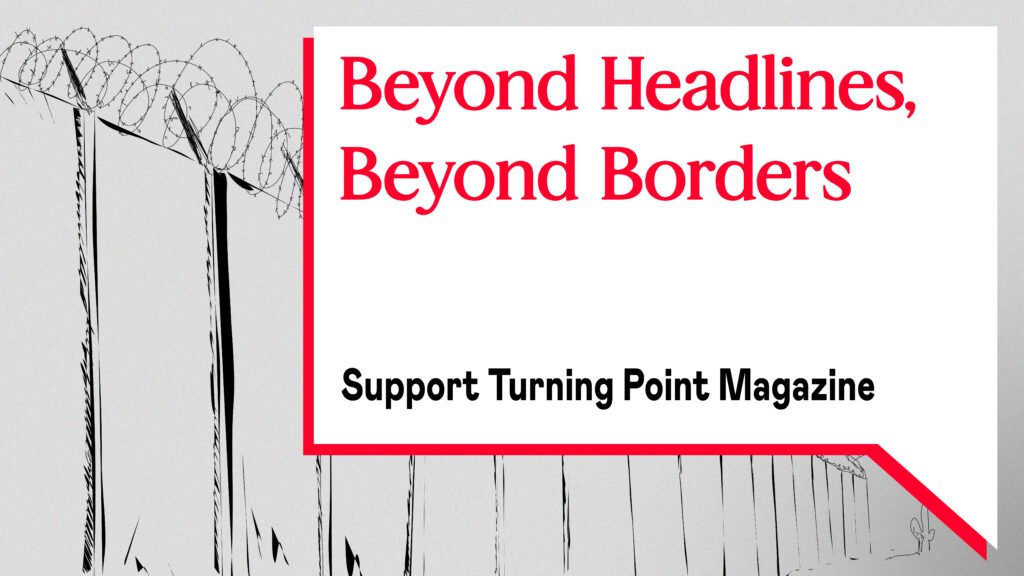Cover photo: Italy, Venice, June 8, 2019: Protest boats on the Grand Canal demand an end to large cruise ships in Venice. The “No Grandi Navi” movement denounces mass tourism and its impact on the city’s fragile ecosystem and social fabric. ©Alexandra Boni
Venice is a city that floats between two worlds: the imaginary and the real. Today a distance has widened so dramatically between these dimensions that a palpable tension lingers in the air. Postcard-perfect beauty suffocates daily life, turning the cityscape into little more than an illusion. For centuries, outsiders have gazed at Venice as a marvel suspended over water, a baroque theater in perpetual performance. Yet for those who live there—or try to—it is increasingly an inaccessible place, stripped of the basic conditions needed for a stable life: elusive housing, disappearing services, and a fragmented community.
In 1951, Venice’s historic center counted 174,000 residents. Now, in 2025, there are fewer than 49,000—a 72% decline in just over seventy years. This collapse is not due solely to an aging population or migration to the mainland. The city has lost much of its social fabric, as homes have turned into short-term rentals, neighborhood shops into souvenir stands, and vast swathes of the urban landscape have been reshaped by the logic of real estate speculation. It reflects a structural transformation: a gradual shift from residential city to tourist playground.
Venice receives millions of visitors annually, with daily peaks sometimes exceeding 100,000 people—a level of pressure unsustainable for a place built on water. The local government’s latest move to introduce an entry fee for day-trippers (5 euros in 2024, rising to 10 in 2025)—was presented as a containment strategy. But to many, it looked like another step in the wrong direction: rather than discouraging hit-and-run tourism, it institutionalized the idea of Venice as a theme park.
The cruise ship phenomenon lays bare the growing disconnect between official declarations and the lived reality of the city’s inhabitants. Pressure from citizens’ committees, environmentalists and residents has prompted the authorities to ban cruise ships from entering the historic heart of Venice, citing safety and cultural heritage protection reasons. Yet, despite the city conceding to a formal ban on large cruise ships entering St. Mark’s Basin, these colossal vessels remain emblematic of Venice’s unsustainable tourism model. Thousands of passengers continue to disembark each week at the terminals of Marghera and Fusina, sustaining a form of high-impact, short-stay tourism that extracts value without reinvesting in the territory. Each cruise ship emits an average of 1,500 kg of CO₂ per kilometer, and while docked, can consume as much energy as a 30,000-inhabitant town, often relying on diesel generators that deteriorate air quality. The vibrations and waves from frequent transits have also contributed to the destabilization of canal walls and erosion of the lagoon floor—causing long-term structural damage to an already fragile ecosystem. This constant flow of tourism exploits the area without ensuring any environmental or social sustenance. In 2019, before the outbreak of the Covid-19 pandemic, Venice had exceeded the threshold of 20 million annual visitors, a number that, after a brief pause, is rapidly returning.
The concentrated arrival of passengers within short time windows leads to overcrowding, pressure on public transport, and rising prices in shops, hotels and short-term rentals—making everyday life increasingly difficult for residents. Giulia Cacopardo is a young activist with ASC (Assemblea Sociale per la Casa), who has lived in Venice for seven years, five of which in a squat. “Venice has become one of the symbols of overtourism. The city aims to attract as many visitors as possible, but this comes at a cost: it has worsened the housing crisis, with more evictions and homes being converted into B&Bs.”
Like Giulia, many residents complain of increasing exclusion from the city center, which is turning into a space for transit and tourist consumption rather than a place for living and community. This overcrowding also fuels job insecurity and contributes to a decline in the quality of services available to residents.
The most brutal instance of this commodification came in June 2025, when Jeff Bezos chose to celebrate his wedding along the Canal Grande. For several days, Venice’s historic center was transformed into a red zone: occupied by mega-yachts, patrolled by helicopters, and secured by private guards and law enforcement. Entire sections of the city were sealed off for a select group of VIPs, sparking public outcry from local activists and civic groups.

Initially set to take place at the Scuola Grande della Misericordia, the wedding celebrations were moved to the Arsenale after protest threats and planned canal blockades. Chants like “No space for Bezos” captured the mood of a broad segment of the population: Venice is not a stage for rent, but a city with a right to exist.
Jacobin Italia rightfully defined the event as a “concrete dystopia”: a symbolic occupation of the city by global capital, which privatizes public space and repurposes it for the pageantry of the transnational elite. During those days, the historic center resembled a theatrical set for the few—a theme park temporarily closed to its own citizens. It wasn’t an isolated incident, but the product of a long-standing process in which economic power has learned to exploit Venice as a stage, a brand, and a political showcase.
What’s been suspended in Venice isn’t just movement through the city, but the very idea of shared space — a sign that, beyond its shrinking population, the city is also losing its symbolic and democratic sovereignty.
It’s a stark reminder of how capital can stop flows — of people, relationships, and meaning— whenever it chooses, reshaping urban space around the needs of profit and control. At the same time, it highlights the limits of weak, piecemeal responses: fragmented policies simply can’t keep up with the structural forces driving exclusion and commodification.
In this scenario, institutions appear either absent or complicit. Urban policies have favored tourism development over social care. Public buildings—decommissioned schools, former municipal offices, historical palaces—have been sold or converted into luxury hotels. University housing has been similarly dismantled or turned into B&Bs. In a city that desperately needs young people and students, they are pushed out by unaffordable housing and the chronic lack of public investment in education and housing rights.
In 2017, the public housing authority ATER managed over 2,000 historic apartments in Venice’s center. Yet, at least 791 remain empty—uninhabitable due to neglect and lack of maintenance—while demand from residents, students, and workers goes unmet. Meanwhile, essential services such as public transport, schools, cafeterias, and health clinics are being scaled back or privatized. As a result, many residents move to Mestre, a mainland suburb of Venice, or beyond—often accepting poorer living conditions but benefiting from more affordable rents and longer, more secure lease contracts, offering greater residential stability.1

And yet, even as Venice resembles a lifeless body, there are attempts to revive it. This is where the issue of the “right to the city” emerges—a concept first articulated by Henri Lefebvre in the late 1960s. Beyond the right to access urban space, it speaks to a demand to participate in its construction, management, and transformation. A collective right, not merely individual. A right to both inhabit, and decide what the city is, and who it exists for.
In 2018, Lefebvre’s ideas were rediscovered in local debates —especially through the work of groups like Biennale Urbana—and explored through workshops and neighborhood events in the most depopulated areas. As highlighted in the project Participation Matters with ASC, the occupation of urban spaces became a form of physical and political reclamation. Restoring an abandoned building, launching a community kitchen, creating a neighborhood library—these are acts of resistance that reconnect people with their territory by reclaiming it from speculation and neglect.
While those who choose to remain in Venice often confront housing and economic precarity; their marginality has shaped new forms of active resistance—one of the most radical of which has been housing occupations. For over a decade, networks of students, precarious workers, migrants, and activists have reopened abandoned buildings, transforming them into homes and community hubs.
Among the most structured and enduring initiatives is ASC Venezia—Social Assembly for Housing—active since 2012. The group has pushed for the direct reclamation of disused public buildings to address housing needs, while challenging the very paradigm of a city sold off to the highest bidder.
Their strategy involves the grassroots regeneration of housing, relationships, mutual aid, and participation. Photographer Nicola Zolin has documented this process: giving voice to the faces, hands, and bodies that reclaim dusty ruins and transform decay into community. It is an act of survival and political defiance, as Tommaso Cacciari declares: “We refuse to surrender to the monoculture of tourism,” echoing one of the collective’s mottos.
These occupations reassert the social function of housing, challenging the transformation of homes into commodities. They remind us that Venice is not a backdrop for advertising, but a place to live. Often, these spaces evolve into cultural labs, solidarity hubs, and gathering points in a city fractured by social atomization. In this sense, Venice exemplifies Lefebvre’s concept: to repair the loss of the right to the city means not only to physically occupy space, but to shape and govern it collectively.
What’s at stake in Venice is far more than a local crisis. It is a paradigm clash between two opposing visions of the city. One views Venice as a common good: a complex social organism built on relationships, tensions, and care. The other—the tourism industry and commercial interests—sees it as merchandise: a cultural product, packaged and ready for Instagram.


ASC’s occupations—in Santa Marta, Cannaregio, Castello, Giudecca—have oppositionally nurtured resilient communities: spaces for social life, popular assemblies, libraries, canteens, and after-school programs. In a system that excludes, these places rebuild belonging.
One of the most powerful tools of resistance has been participatory mapping. The OCIO project—Civic Observatory on Housing—revealed that over 33% of historic Venice’s homes are often left empty. Despite institutional warnings about a housing crisis, thousands of properties lie vacant or have been converted into tourist rentals. This pattern is not unique to Venice—it reflects a broader trend seen across Western Europe and other advanced capitalist cities, where housing increasingly serves market interests over residents’ needs. It’s a cruel paradox: the homes exist, but not for those who need them. ISTAT’s (Italy’s national bureau of statistics) data from 2021 confirms this: more than one in three homes are vacant, and the resident population continues to shrink. Young couples, students, and precarious workers are forced to move to Mestre, Marghera, or even farther away.
When activists or groups occupy buildings, these are not merely acts of rupture but forms of social self-organization responding to systemic failure. In a city where public assets are sold off, and even former barracks and hospitals are turned into hotels, occupying space becomes a political demand. It’s not just about having a roof overhead—it’s about reclaiming urban space for those who live in it, not those who exploit it.
Naturally, conflict arises. Occupations are often criminalized, their inhabitants labeled as squatters, and projects evicted with force. But repression has never solved the problem—only deepened the exclusion and isolation familiar to many Venetians. Where institutions see decay, occupiers see potential: regeneration, solidarity, life.
In this context, the recent Decreto Sicurezza, approved in Italy in April 2025, introduces harsher penalties aimed at cracking down on squatting, framed as a fight against the illegal occupation of public and private buildings. The law permits arrest in flagrante delicto, sentences of up to two years, and significantly expands police powers to carry out immediate evictions. Strongly backed by the Ministry of the Interior under Matteo Piantedosi, the decree has sparked sharp criticism from legal experts, urban planners, and housing rights activists. They warn that it risks punishing those already marginalized by social hardship, while failing to address the deeper, structural causes of the housing crisis.
Today, over 650,000 families in Italy wait for social housing, even as countless public properties remain empty or abandoned (MIT, “Piano Casa,” 2023). ISTAT reports that in 2023 nearly 33,000 evictions were executed due to rent arrears—a figure steadily rising and reflecting the growing economic pressures on many families (ISTAT, “Evictions for Non-Payment of Rent and Lease Expiry,” 2024). Across the country’s cities, occupying vacant buildings has become a necessary act of resistance against a housing system that increasingly excludes those in need, amid a shrinking stock of rent-controlled homes and escalating evictions.
Against this backdrop, many fear that the decree’s repressive measures will only deepen the crisis—resulting in more evictions without viable alternatives, pushing the most vulnerable further to the margins—rather than confronting the structural failures at the heart of Italy’s housing emergency.
Although Venice is unique due to its millennia-old history and extraordinary geography, it is not isolated from the transformations affecting many European cities. Barcelona, Lisbon, Berlin, Florence, Amsterdam, and Paris, to name a few, share a common fate: being emptied by gentrification, rampant tourism, and the growing privatization of housing and social spaces. These processes fuel an urban model dominated by capital, one that erodes community networks and subordinates everyday life to a market logic. In this sense, Venice is not an exception but rather a critical laboratory and a symbol of collective resistance, exposing the contradictions and limits of an increasingly commodified global model.
In recent years, efforts have been made to propose alternatives to the current tourism-dependent economy. Urbanists and activists have suggested reclaiming unused or privatized public assets for affordable housing, community spaces, and resident services. But they face a city economy increasingly driven by rent. According to city data, more than 450 public properties were sold or privatized over the last decade—many turned into hotels or corporate offices.
Meanwhile, the surge in short-term rentals has decimated long-term housing. According to Inside Airbnb, over 60% of listings in Venice’s historic center are entire apartments, often run by professional hosts. A Investigaciones Regionales study has directly linked the rise in non-hotel tourism to the city’s residential exodus.
Facing this, groups like ASC are calling for stronger regulations: rent controls, bans on residential-to-tourist conversions, and greater transparency from rental platforms. “You can’t keep treating the city like a product,” says Chiara Buratti, a long-time activist, “or it will end up completely hollowed out.”
Martina Vergnano, a university student who has been living in the lagoon for several years, echoes her sentiments: “We’ve been doing this for years: we occupy houses, we report ATER’s mismanagement, and at the same time we take care of the common areas.”
Venice’s housing crisis is no accident but the result of deliberate choices made by the local administration. As the city empties and becomes a showroom, acts of resistance and reclamation carve out space for a different future. This is not just a battle over buildings. It is a fight over who has the right to live in the city—and for how much longer that will even be possible. In the shimmering reflection of the canals, a question remains: can Venice be saved—not by capital— but by those who still dare to live in it?
1 Francesco Biagi, Prefazione a Spazio e politica. Il diritto alla città II di Henri Lefebvre, Globalproject, february 27, 2018.

Anna Irma Battino
Anna Irma Battino is a freelance journalist covering international politics, social justice, and transfeminism. She reports from global and local contexts, including Palestine, Latin America, Kurdistan, and Venice. Her work appears in il manifesto, Limes, Jacobin Italia, and other independent media. She is passionate about cinema and its role in storytelling.




